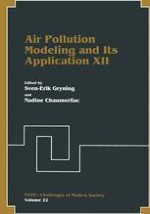1998 | OriginalPaper | Buchkapitel
Regulatory-Oriented Features of the Kinematic Simulation Particle Model
verfasst von : Arno Graff, David Strimaitis, Robert Yamartino
Erschienen in: Air Pollution Modeling and Its Application XII
Verlag: Springer US
Enthalten in: Professional Book Archive
Aktivieren Sie unsere intelligente Suche, um passende Fachinhalte oder Patente zu finden.
Wählen Sie Textabschnitte aus um mit Künstlicher Intelligenz passenden Patente zu finden. powered by
Markieren Sie Textabschnitte, um KI-gestützt weitere passende Inhalte zu finden. powered by
Realizing the need for a dispersion model which explicitly considers non-steady state emissions and arbitrarily complex, space-time varying meteorological conditions, and the desirability of having a model which can yield the probability distribution function (PDF) of concentrations rather than simply the ensemble mean, the German Federal Environmental Agency (UBA) funded the development and preliminary testing of an advanced atmospheric dispersion model, referred to as the Kinematic-Simulation-Particle (KSP) Model. The KSP modeling system (Yamartino et al.; 1993–6, and Strimaitis et al., 1995) includes dry and wet removal processes, many other of the processes (e. g., stack and building downwash, plume rise, partial lid penetration) included in the CALPUFF (Scire et al.; 1990, 1995) puff model, and computes the space-time average and percentile concentrations required by German and EC legislation; however, KSP also has the intrinsic capacity to predict the short-term concentration fluctuations that are critical to the assessment of odor and hazardous chemical exposure problems. A key model input involves the 3-d gridded mesoscale wind fields and accompanying 2-d fields specifying boundary layer quantities. These data may be provided by an external wind field/PBL model, or, in the case where only single-point measures of wind and stability are available, an internal flow and turbulence generator creates a vertical profile which emulates the dispersion conditions specified in the German regulatory guideline (TA-Luft). The current KSP model also accesses data produced by the CALMET diagnostic model (Scire et al., 1990; and U.S. EPA, 1995), and an interface to the GESIMA prognostic model has been developed by Reimer et al. (1994) that allows the modeled TKE budgets to be used in the computation of turbulence fields. Expansion of this interface to permit METRAS (Schluenzen et al., 1994) generated winds and turbulence to be utilized is also envisioned.
